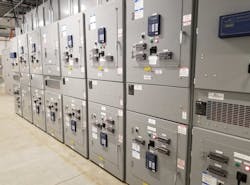- With 60-week lead times for replacement equipment and supply chain disruptions, waiting until switchgear fails can result in costly unplanned downtime and safety hazards.
- Upgrading circuit breakers and components can be completed in 25-30 weeks versus 60 weeks for full replacement, while incorporating modern safety features and protection technologies.
- Retrofitting existing switchgear can save $500,000+ in equipment costs and up to $250,000 in labor expenses compared to complete system replacement.
Electrical infrastructure is the heartbeat of industrial facilities that power automated systems. Unfortunately, as facilities age, the equipment that once stood as the backbone of electrical power distribution system — such as switchgear — becomes less reliable and more prone to failure.
Switchgear has a lifespan of 25-40 years and, as you may have guessed, many companies wait to start looking for quotes on new systems at the 40-year mark. Despite recognizing the equipment as outdated, few are looking to make potentially significant capital investments when their equipment is still functioning. However, delaying the process can lead to bigger issues, as the risks associated with outdated switchgear are not trivial. These risks include unplanned downtime, safety hazards and significant financial losses.
Instead of waiting until troubles emerge, modernizing and revitalizing aging infrastructure can help avoid issues before they start.
Following are the three best practices for updating switchgear:
Guard your guardian
Switchgear isn’t known as the “guardian of the grid” for nothing. The pivotal role it plays in managing electrical power distribution can’t be overstated. Switchgear regulates the flow of electricity and protects against overcurrents and short circuits and ensures that power is safely and efficiently distributed to where it is needed most. As components wear out and technology becomes obsolete, the likelihood of malfunctions and equipment failure escalates.
Lead times for replacement parts have become a significant issue, especially with recent supply chain disruptions. Couple this with the fact that much of the equipment in the field is at or nearing the end of their lifespan, and you have a large number of machines that are going to need replacement or repair in the same time frame. That’s why many industrial companies are shocked to learn that it's an average of 60 weeks for replacement equipment, and nearly as long for new transformers.
Pro tip: Waiting until your switchgear is outdated could mean costly downtime that could have been avoided by investing in the equipment earlier. It can also result in safety concerns. Fixing problems before equipment failure requires paying attention to equipment needs starting at year 25 rather than year 40.
Extend equipment life with upgrades and retrofits By upgrading existing switchgear with new, state-of-the-art circuit breakers and retrofit options, facilities can improve their reliability and safety. Examples include low- and medium-voltage replacement, circuit breaker maintenance (performed at 10-year intervals), power circuit breaker reconditioning, remanufacturing and enhancements, low- and medium-voltage switchgear retrofills, breaker-to-motor starter replacements and remote racking systems.
Upgrading and modernizing the existing switchgear lineups also reduced the potential for arc flash incident energy by activating the Arc Flash Reduction Maintenance System and lowering the pickup point of the breaker's instantaneous trip function.
Ultimately, it's the breakers inside the switchgear that regulate the electrical loads. They not only need to be operational, but they also need to protect from over currents and short circuits. Upgrading to modern circuit protection can be done with minimal power interruptions. This can extend the useful life of the equipment by up to 30 years. These upgrades also incorporate the latest technologies that enhance performance and reduce the risk of failure.
This is especially relevant as breakers can be replaced far more quickly than new switchgear. For example, breaker retrofits can be done in 25-30 weeks compared to a 60-week lead time for transformers and other equipment.
Pro tip: If you go the retrofitting route, ensure that you follow the IEEE C37.59 standard that governs switchgear conversion. This standard provides directions and requirements for the conversion of qualified power switchgear equipment.
Take advantage of safety features
While retrofits can be used to extend the life of equipment, saving time and money in the process, it can also have an unintended benefit — implementing the most up-to-date safety features and functions.
Breakers inside the switchgear regulate electrical loads and are used to protect from over currents and short circuits. Upgrading to modern circuit protection can be done with minimal power interruptions and can extend the useful life of the equipment by up to 30 years.
For example, we recently performed a retrofit with a large paper mill. While their switchgear was very old, the enclosure and bus were in good shape, so they went with a retrofit to avoid the extra material labor expense. While the retrofit saved them $500,000 in equipment costs alone, it also saved on the labor costs of moving the motor control center, removal of the old switchgear equipment, pulling wires, installation of new connectors and the bus work, which would have cost $200,000-$250,000. Since breakers were available onsite, the retrofit was completed in 12-15 weeks with minimal downtime.
Upgrading and modernizing the existing switchgear lineups also allowed the paper mill to realize an additional safety benefit with the ability to reduce arc flash incident energy by activating the Arc Flash Reduction Maintenance System and lowering the pickup point of the breaker's instantaneous trip function. This feature, which is inherent on most modern power circuit breakers, ensured that the customer was staying current on equipment safety options as it upgraded its gear without making a huge capital investment.
Bottom line: Modernizing aging switchgear is not just a matter of maintaining operations; it is about setting the stage for a more reliable, efficient and safe power distribution system for years to come.
Nelson Squires is executive vice president and general manager of electrical and electronic solutions at Wesco International.
More automation insights from Automation World:
About the Author

Leaders relevant to this article:

